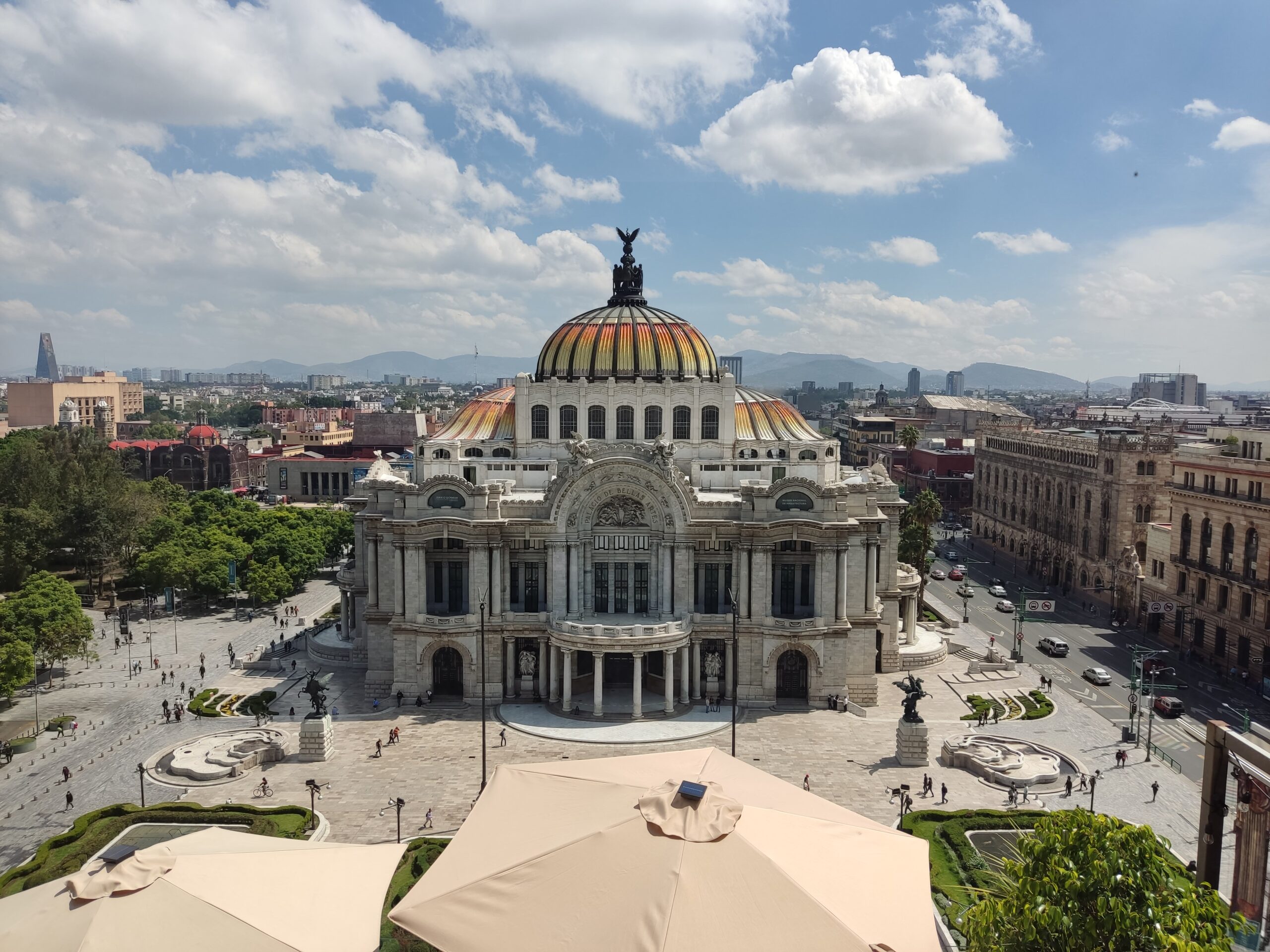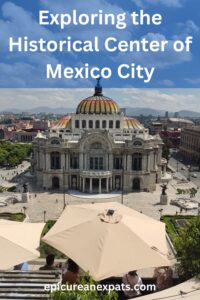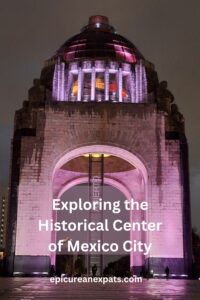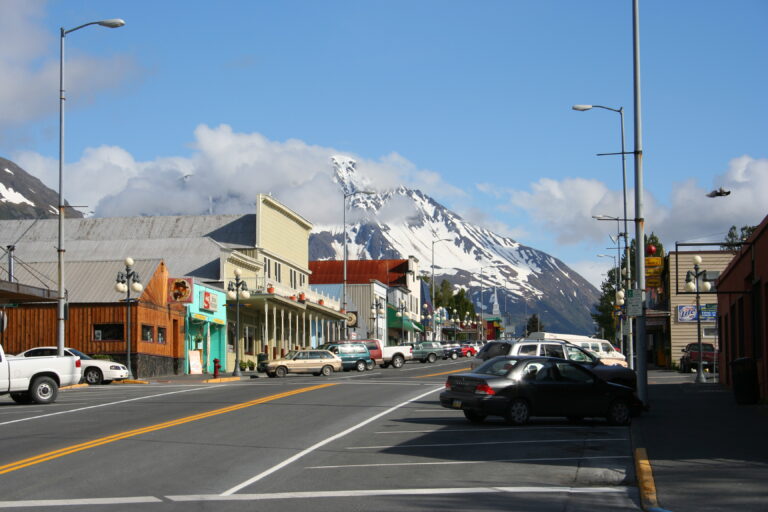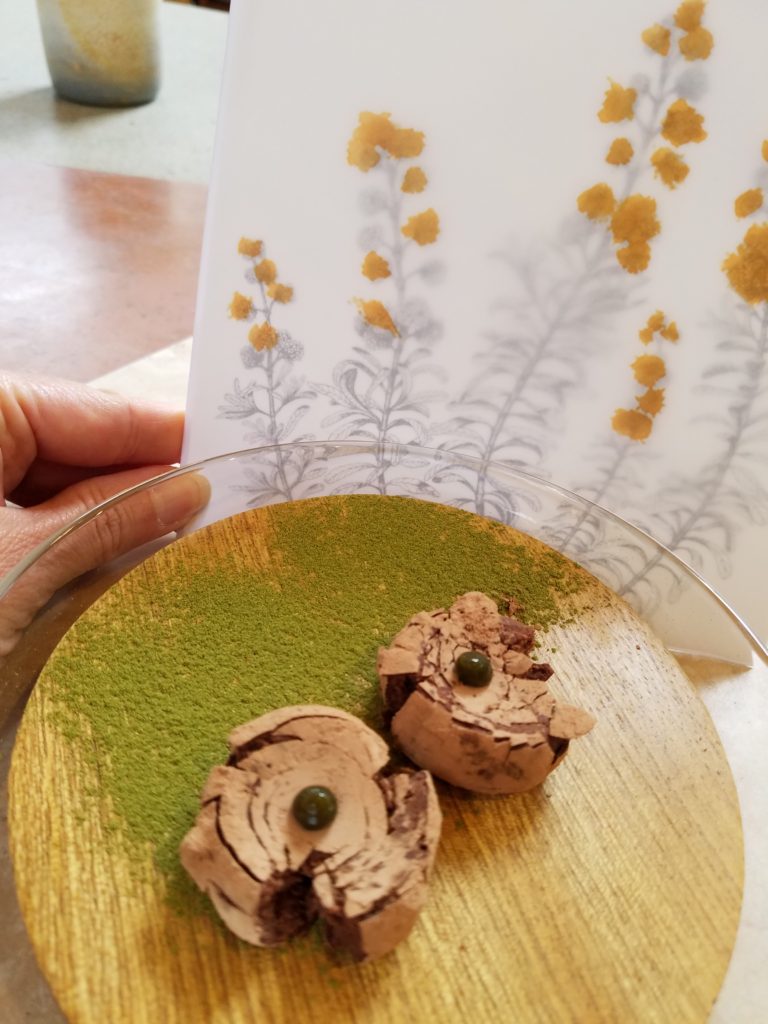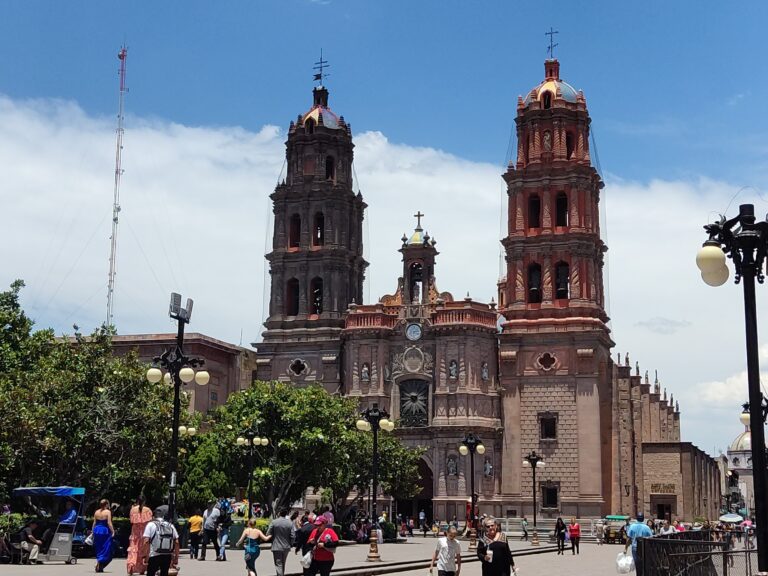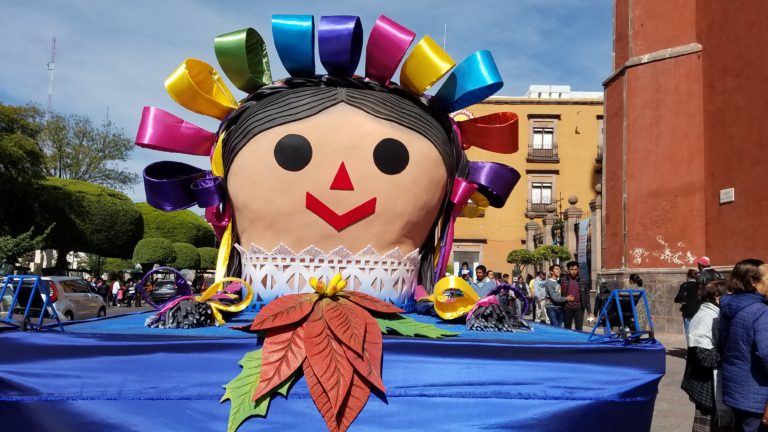Exploring the Historical Center of Mexico City
From the largest cathedral in the Americas to skyscraper views and Aztec ruins, it’s hard to know where to start sightseeing in Mexico City. We’ve visited this area several times and still have not seen everything. After a lot of wandering and some research, we’ve put together a list of landmarks, monuments, and museums not to miss in the historical center of Mexico City.
Disclosure: This post does contain affiliate links where we will receive a super small commission at no cost to you.
In this post:
- How to Get to the Historical Center of Mexico City
- Plaza de la Constitucion
- Metropolitan Cathedral
- Palacio Nacional
- Templo Mayor
- Av. Francisco 1. Madero Walking Street
- Museo de Estanquillo
- Templo de San Felipe de Neri la Profesa
- Palacio de Cultura Banamex
- Templo Expiatorio Nacional de San Felipe de Jesús, Atrio de San Francisco, and Templo de San Francisco
- La Casa de los Azulejos- House of Tiles
- Torre Latino
- Post Museum (Museo Palacio Postal)
- Palacio de Bellas Artes and the INBA Museo National de Arquitectura
- How to Get the Best View of the Palacio de Bellas Artes
- Alameda Central
- Hemiciclo a Juarez
- Museo Mural Diego Rivera
- Monument to the Revolution (Monumento a la Revolucion)
- South of the Zocalo- various historical buildings
- North of the Metropolitan Cathedral- Antiguo Colegio de San Idelfonso and Plaza Garibaldi
- Where to Stay in the Historical Center of Mexico City
- Where to Eat in the Historical Center of Mexico City
- How Much Time Do I Need to See the Historical Center of Mexico City?
HOW TO GET TO THE HISTORICAL CENTER OF MEXICO CITY
Mexico City is the largest city in the Americas boasting 23 million citizens. In comparison, New York City is home to only 9 million people. The best modes of transportation within Mexico City are Uber or the Metro. We have tried taxis, but many of the drivers do not use GPS. If they take a wrong turn, it can easily add an extra 30 minutes to your trip.
METRO STATIONS
The historic area and Zocalo can be accessed by these metro stations:
- Hidalgo– By Reforma on the other side of the Alameda Central Park
- Bellas Artes– in between Alameda Central Park and Bellas Artes
- Zocalo– in Plaza de la Constiticion
STARTING POINT: THE ZOCALO
Plaza de la Constitucion
The largest plaza in the Americas and the central point of the historical center of Mexico City is the Plaza de la Constitucion, better known as the Zocalo. This was the main ceremonial center of the ancient city of Tenochtitlan, an important Aztec city in the 1300s. The word zocalo, meaning base or plinth, has been adopted by many Mexican cities for their main plazas. The Zocalo in Mexico City wasn’t named the Plaza de Constitucion until 1813. Ironically, the War of Independence was still raging across Mexico during this time.
A Little History About Tenochtitlan
Before Cortez arrived, the city was called Tenochtitlan. This was a city of palaces and an infrastructure not seen in many parts of the world. They had aqueducts to bring water into the city, drainage systems, canals, and paved streets. After Cortez seized the city in 1521, he leveled Moctezuma’s Palace and other pre-Hispanic buildings and used the rubble to construct the Metropolitan Cathedral and federal buildings.
Around the Zocalo
The Metropolitan Cathedral was built to the north of the plaza, and the Palacio National was built to the east. On the southside of the Zocalo is the Antiguo Palacio del Ayuntamiento and the Secretaria de Goberno buildings. The western side of the Zocalo now houses retail stores, restaurants, and hotels.
Once a green area filled with gardens and park benches, today the Zocalo is a large, empty cement square home to political rallies and festivals with an enormous Mexican flag waving in the center. (It was also the opening scene in the James Bond movie Spectre).
Metropolitan Cathedral of the Assumption of the Most Blessed Virgin Mary into Heavens
Catedral Metropolitana de la Asunción de la Santísima Virgen María a los cielos
On the north side of the Plaza de Constitucion is the Metropolitan Cathedral, the largest and oldest cathedral in the Americas. It’s also the seat of the Catholic Bishop of Mexico.
The cathedral was built over 250 years between 1573 and 1813 with the foundation alone taking 42 years to lay. Mexico City sits on a drained lakebed, and the combination of soft clay and frequent earthquakes has led to many architectural challenges including parts of the cathedral sinking. When you enter, head towards the right and you will notice part of the building leaning. Work to stabilize the cathedral’s foundation takes place to this day.
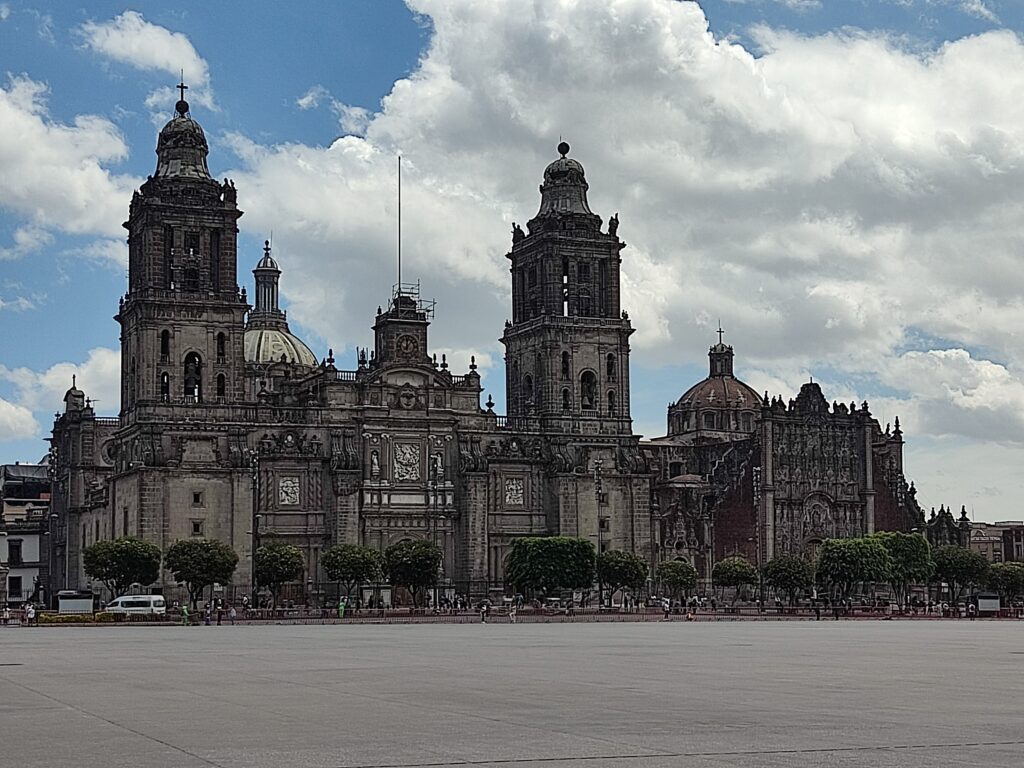
The expanse of the cathedral is striking from the outside, but the real treasure is in the interior. Soaring columns, elaborate gold-leaf altars and impressive organs will invite you to take the time to sit and reflect on the artistry of this remarkable monument.
Free admission.
Palacio Nacional
The Palacio Nacional was used as a presidential residence, but today it is a government building housing the Federal Treasury and the National Archives. Enter from the side street Calle Moneda to the right of the Cathedral (not the main plaza doorways) to view the impressive murals by Diego Rivera. The murals represent the Mexican people from the pre-Hispanic era, Spanish conquest, and Mexico independence era.
If your visit coincides with the Mexico’s Independence Day celebrations on September 15 and 16, you can witness El Grito. The President, or another high official, enters the balcony overlooking the Zocalo and shouts the “Cry of Independence” that began the Mexican War of Independence from Spain in 1810.
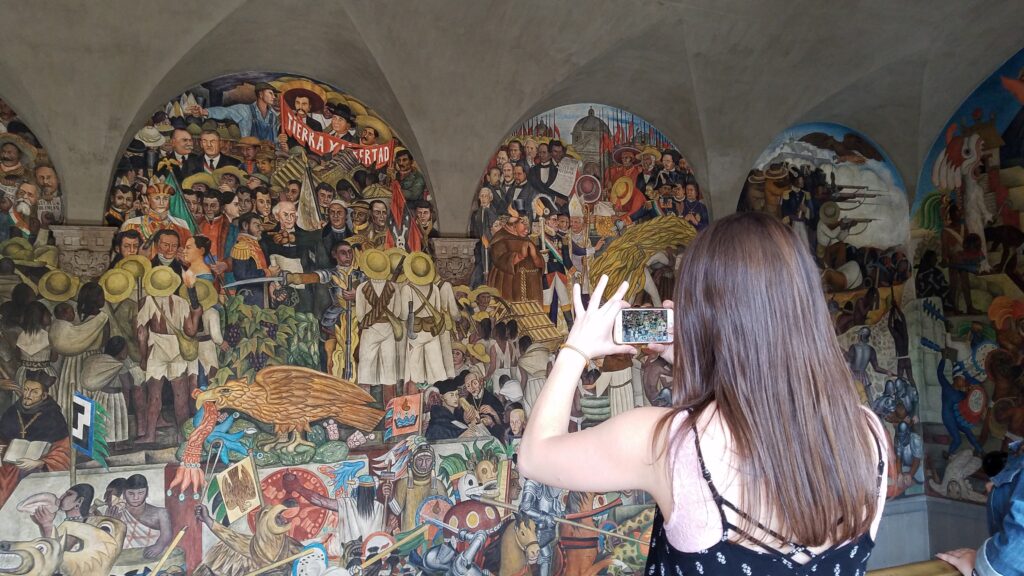
Templo Mayor
Between the Cathedral and the Palacio National are the ruins of Templo Mayor. It’s an impressive site and well worth a few hours. A tour guide will point out interesting features, or you can walk through on your own and read the informative plaques. At the end of the excavations is a large modern museum with many relics that they have found in the excavations.
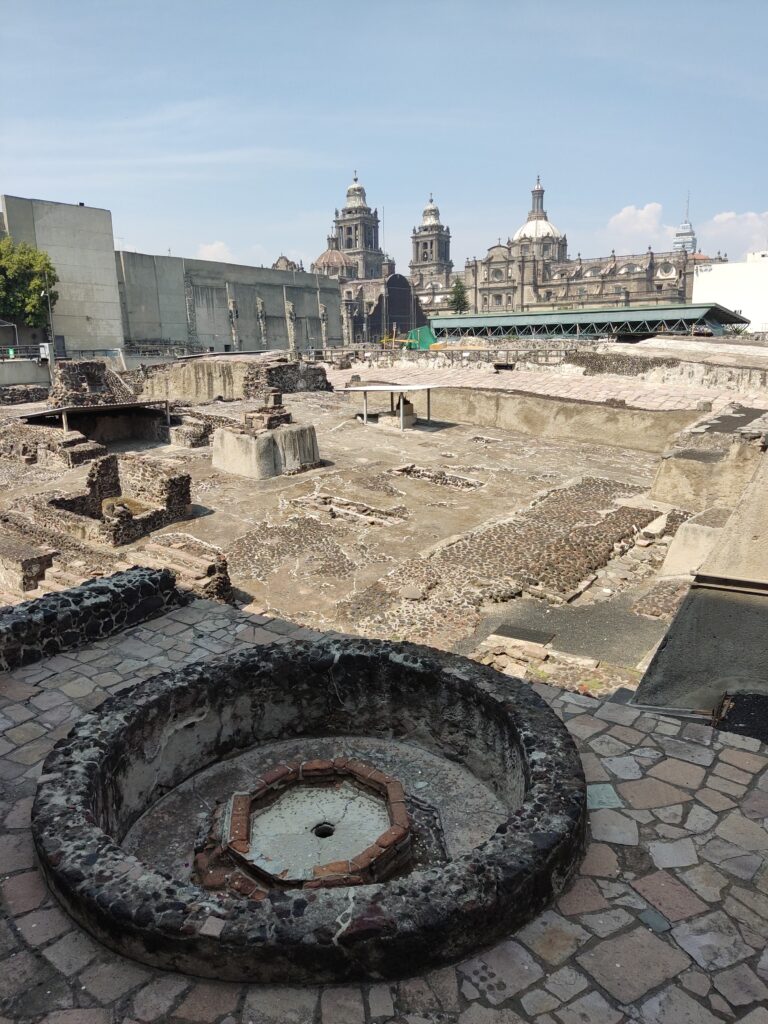
TRAVEL TIP: We recommend getting to Templo Mayor when it opens because the first excavation part is outside without shade. The modern museum is air-conditioned.
Note: You will have your bag searched and certain items will be held at the check-in counter until you return. These include water bottles, lipstick, eyeliner, nail files, etc. You can retrieve your items after you exit back at the entrance.
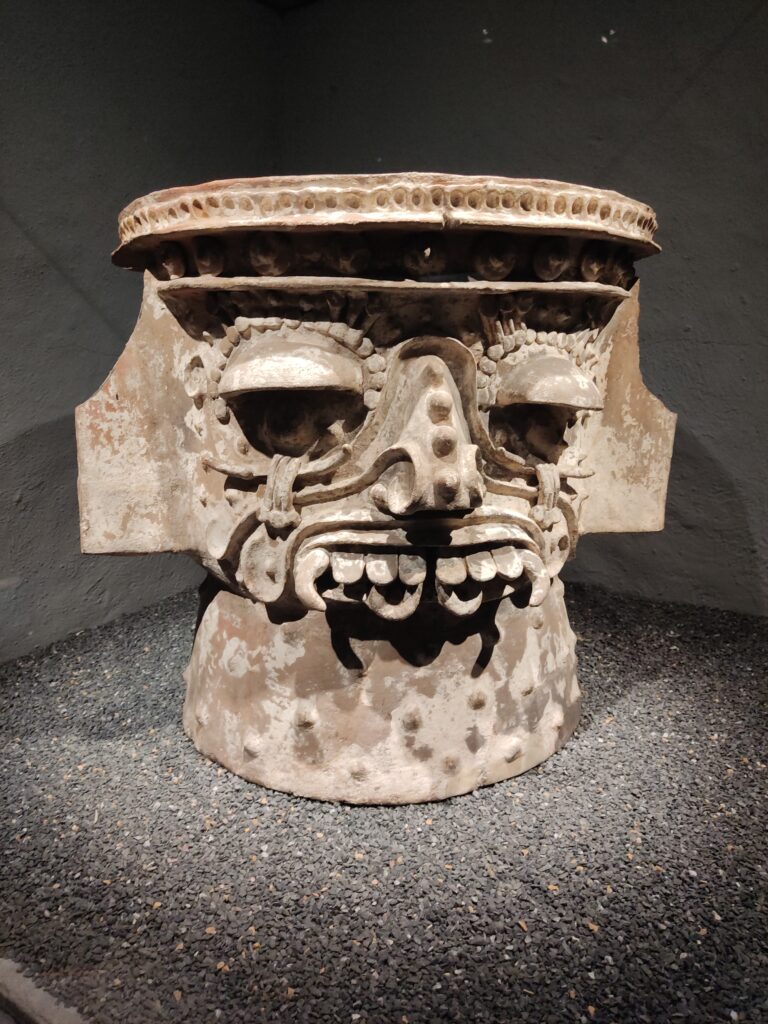
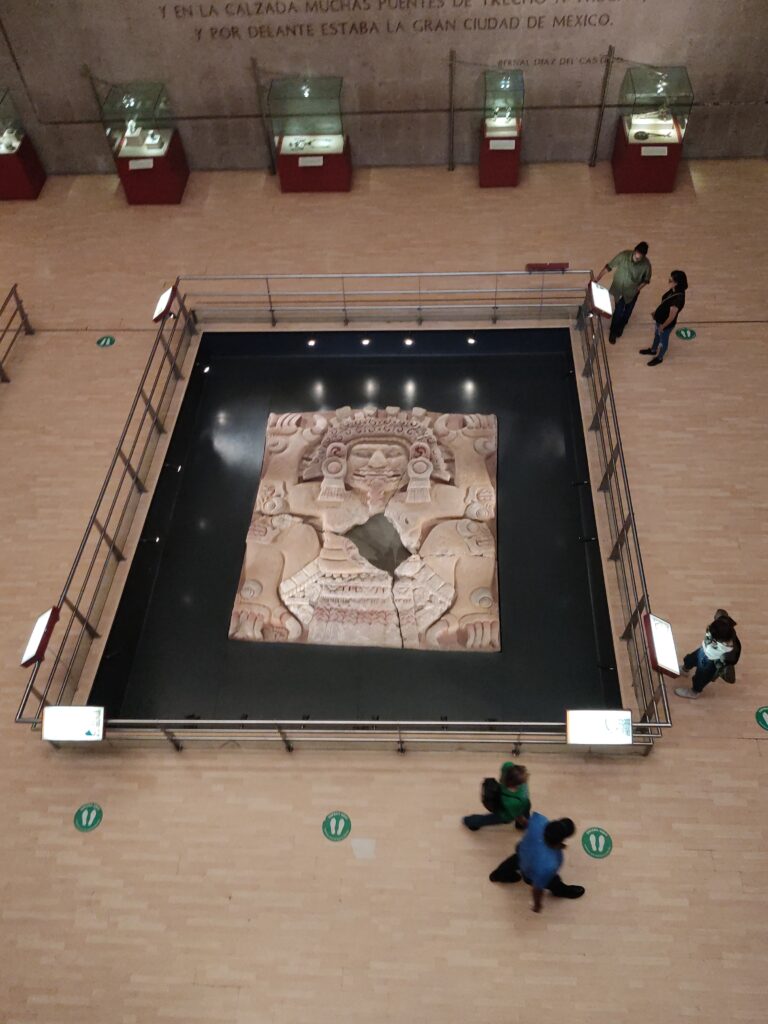
What else surrounds the Plaza?
On the west side of the Zocalo are two grand hotels, the Best Western Majestic and the Gran Hotel Ciudad de Mexico. Both have spectacular views of the Zocalo and cathedral from their rooftop terrace restaurants.
Not staying in either of these hotels? Not a problem. You can still visit their rooftop bar/restaurants, and we highly recommend you do. Make reservations.
You might recognize the stained-glass roof and old-fashioned elevators in the Gran Hotel Ciudad de Mexico from the opening scene of the James Bond movie, Spectre.
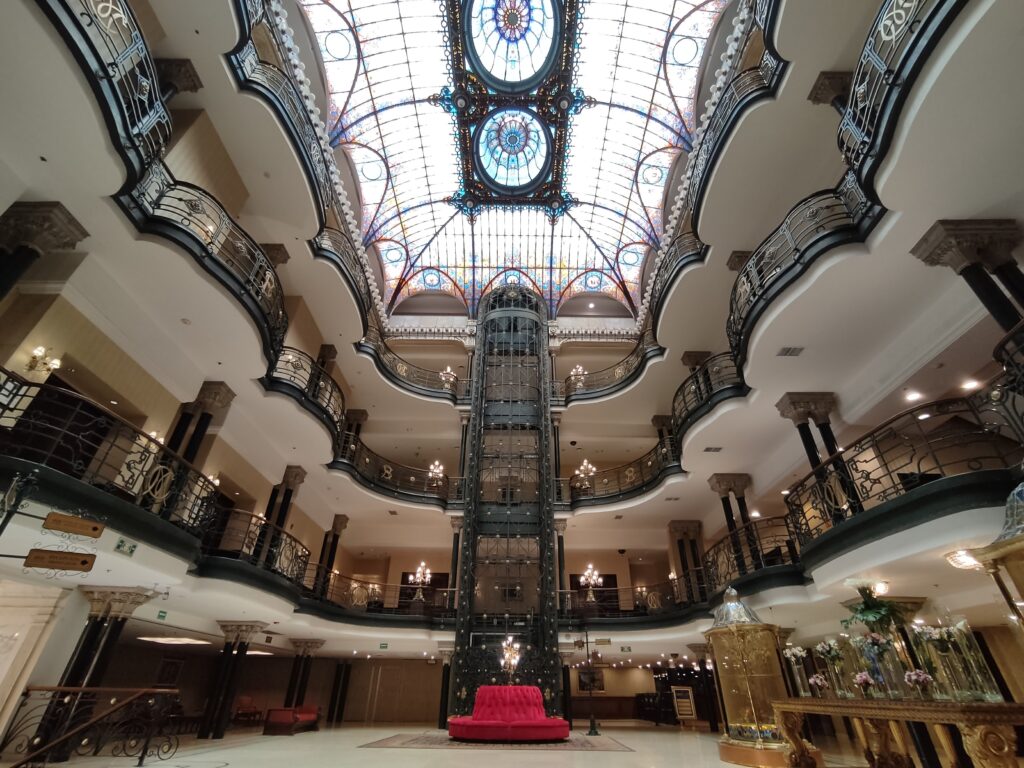
WEST OF THE CATHEDRAL TOWARDS BELLAS ARTES
Av. Francisco 1. Madero Walking Street
Facing the front of the cathedral again, head to the left down the walking street Av. Francisco I. Madero. Jewelry, clothing, and shoe stores line both sides with plenty of places to enjoy a taco or ice cream for a snack break.
Museo de Estanquillo
Continue along the walking street and the Museo de Estanquillo will be on your left. This museum houses the personal collection of toys, paintings, and photos of Mexican philosopher and writer Carlos Monsivais (1938-2010).
Templo de San Felipe de Neri la Profesa
On the cross street Isabel La Católica you’ll find Templo de San Felipe de Neri la Profesa with its neoclassical interior.. This church was where secret meetings to stop the independence movement in 1810 took place.
Citibanamex Culture Palace (Palacio de Cultura Banamex)
Stop and admire the Baroque facade of the Palacio de Cultura Banamex once the Palacio de Iturbide. It was built by the Count of San Mateo Valparaíso as a wedding gift for his daughter between 1779 and 1785. Augustin de Iturbide lived here from 1821-1823, hence the name. Iturbide was the first Mexican president and Emperor of the Mexican Empire after it gained independence from the Spanish in 1821. Built to replicate the palace in Palermo, Sicily, today it is a cultural center with temporary art exhibitions and art workshops.
Templo Expiatorio Nacional de San Felipe de Jesús, Atrio de San Francisco, and Templo de San Francisco
The Templo Expiatorio Nacional de San Felipe de Jesús built in 1897, is notable for its unique neo-Romanesque style. Nearby is the Atrio de San Francisco, an plaza with unique sculptures including a Salvador Dali melting clock. The Templo de San Francisco is almost hidden, but its elaborate facade and and altar are quite spectacular.
La Casa de los Azulejos- House of Tiles
Continue down Madero and take a right on Calle de Condesa to see La Casa de Azulejos or House of Tiles. Built in the 18th century, it is covered on 3 sides with blue and white tiles from the city of Puebla and carved stone. Inside the courtyard is a beautiful fountain under a stained-glass roof, murals, and the flagship restaurant of Sanborn’s. This is a perfect spot to enjoy a lunch or late afternoon pastry.
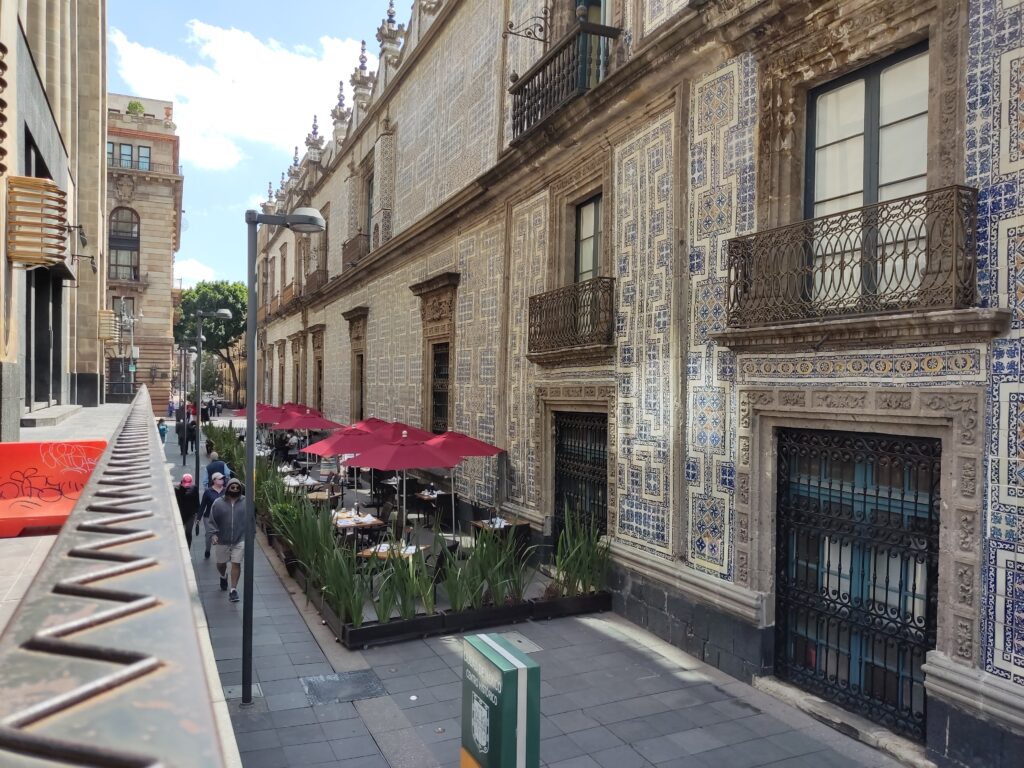
Torre Latino
At the end of the walking street on the left is Torre Latino, an ugly building on the outside, but full of historical potential on the outside. You could easily spend half a day or more visiting the Mexico City Museum, the Bicentennial Museum, shops, eating at Miralto Restaurant & Bar, and viewing the city from the observation deck.
Completed in 1956, Torre Latino was the tallest building in Latin America at that time. The Mirador (observation deck) is on the 44th floor and offers spectacular views across the city. The visit to the Mirador includes admission to the Bicentennial Museum. We recommend going here towards dusk to see the lights of the city. It’s open from 9am-10pm every day.
TRAVEL TIP:
Mexico City Museums are closed on Mondays.
Post Museum (Museo Palacio Postal)
Before we cross the street from the Torre Latino to Palacio de Bellas Artes, walk to the right one block up along Eje Central Lázaro Cárdenas. On the next corner is the Post Museum (Museo Palacio Postal). Walk inside and you will see the grandest staircase you have ever seen in your life.
This building was commission in the early 20th century, but incorporated several artistic styles such as Art Nouveau, Gothic, Baroque, and Neoclassical. Supposedly, this Palace of Mail is still in operation today, which is kind of ironic. Ask any Mexican if they get mail, and they will tell you “Not often. It’s very slow”.
Palacio de Bellas Artes and the INBA Museo National de Arquitectura
Cross over Eje Lazaro Cardenas from either Torre Latino or the Museo Palacio Postal and you will see the most gorgeous structure in Mexico City, Palacio de Belles Artes. To get the full building in your picture, stand across the street from the front of it.
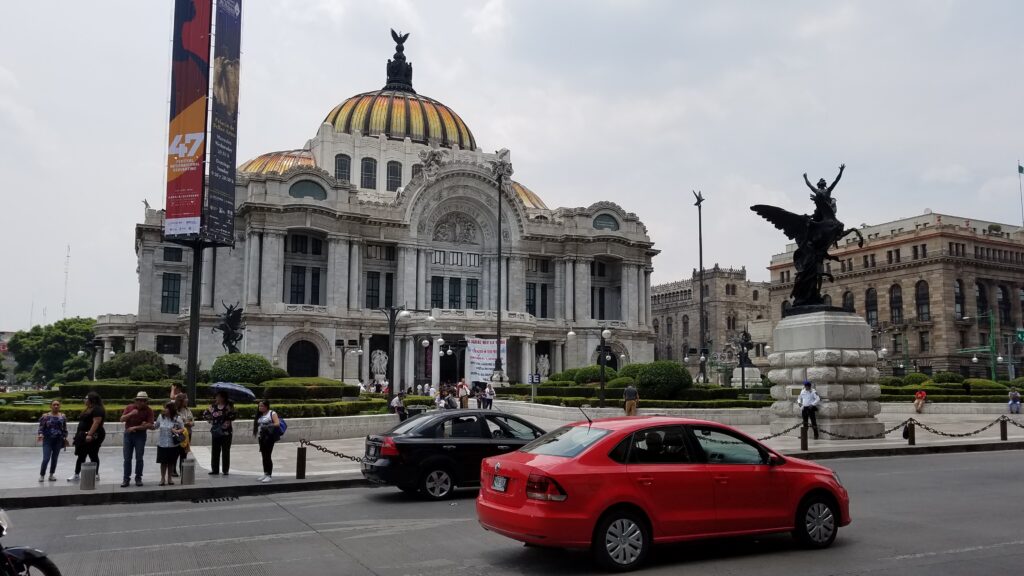
The land where the Palacio de Belles Artes currently stands was once a significant Aztec site, a convent, textile mill, housing area, and National Theatre before being converted to its present-day glory. Between the 19th and early 20th century the National Theatre was the cultural venue for the high class hosting international performances and dance troupes.
In 1901, it was decided to build a grander theatre for the Centennial celebration in 1910. Unfortunately, because of the soft terrain and the outbreak of the Mexican Revolution in 1910, construction was delayed for 20 years. Building resumed in 1932 under Mexican architect Federico Mariscal who opted for more of an Art Deco style compared to the former architect’s Neo-classical style. It was completed on September 29, 1934.
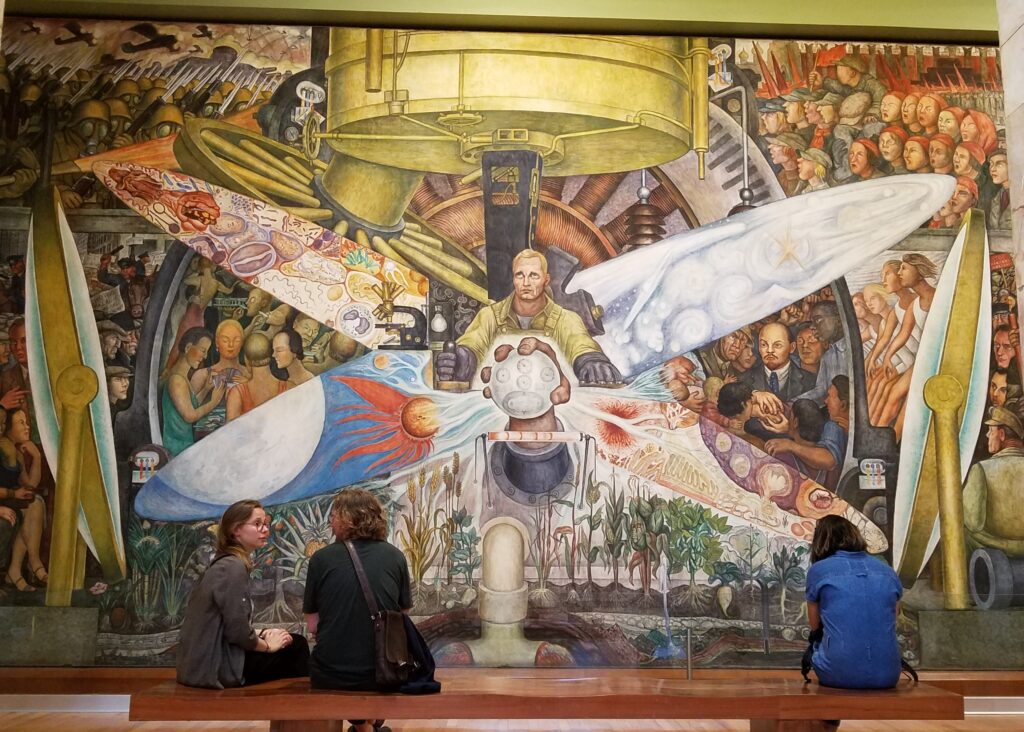
The outside of the building still retains it’s Art Nouveau style while the interior displays Art Deco. Inside, is a theater and several floors with permanent and temporary exhibits. View murals painted by renowned artists Diego River and José Clemente Orozco.
*Admission to the Palacio de Bellas Artes is free on Sundays.
How to Get the Best View of the Palacio de Bellas Artes
For the best view of the Palacio de Bellas Artes, enter Sears and head to the 8th floor where there is a little outdoor rooftop café that serves excellent Café atolla and Mexican hot chocolate. You will have to make reservations. They no longer let people in just to get the perfect picture of Bellas Artes.
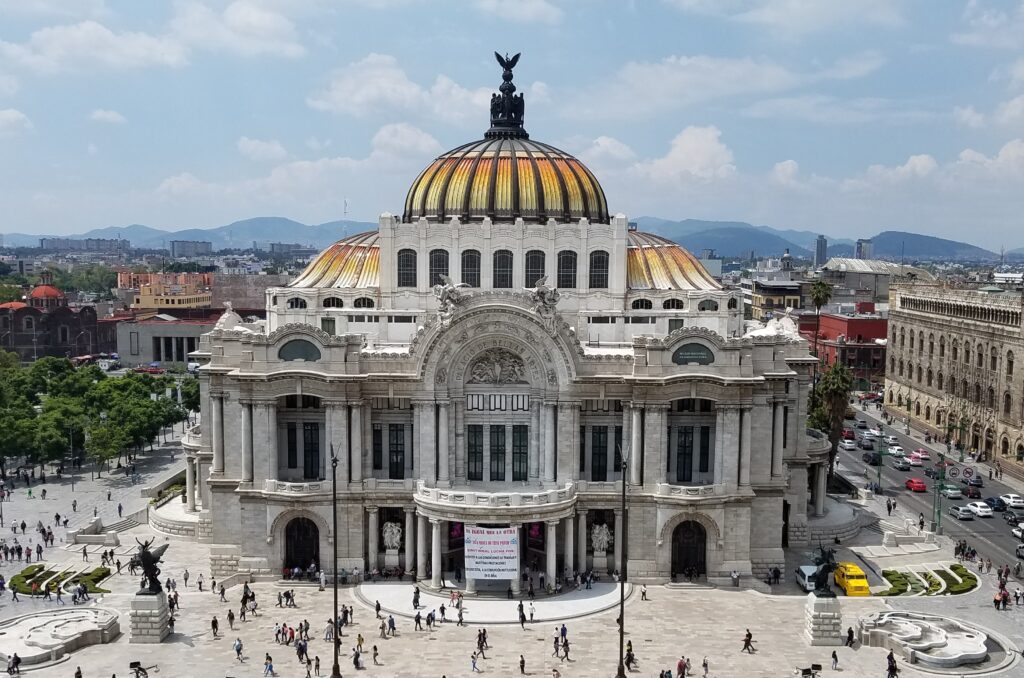
Alameda Central
Continue past the Palacio de Bellas Artes to Alameda Central, the largest municipal park in Mexico City. Created in 1592, this was a former Aztec marketplace. Today, it’s a peaceful green haven amid the chaos of city traffic. Greco-Roman fountains and statues named after gods are scattered along the pathways.
Gas lamps were installed in 1868, which were replaced by electrical lighting 1892. By the end of the 19th century, the park had become popular with all social classes in Mexico. The current park layout with its starburst pattern of paths around fountains and the central kiosk dates from the late 19th and early 20th centuries.
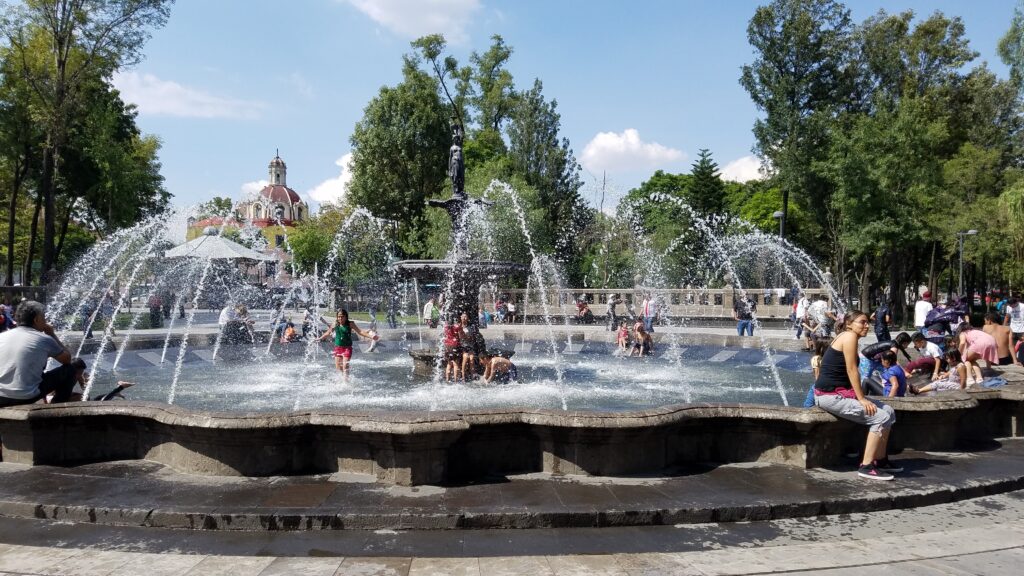
Hemiciclo a Juarez
On the south side of Alemeda Central stands an impressive monument to former President Benito Juárez. This neo-classical monument was built in 1910 and is constructed in marble imported from Carrara, Italy.
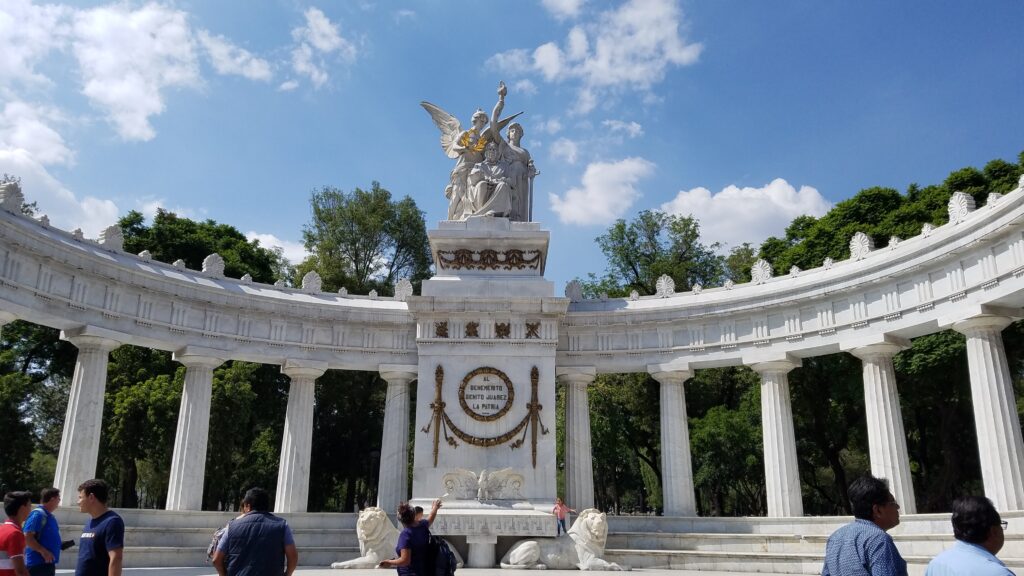
Across the street from the this monument is the Memory and Tolerance Museum. To the north are the Teatro Hidalgo Ignacio Retes, the Frank Mayer Museum, and the Museo Kaluz. To the west is the Diego Rivera Mural Museum (Museo Mural Diego Rivera).
Museo Mural Diego Rivera
In 1985, Mexico City experienced a catastrophic earthquake that severely damaged many buildings in the city including the Hotel del Prado where one of Diego Rivera’s prized murals was displayed. The Sueño de una Tarde Dominical en la Alameda Central (Dream of a Sunday Afternoon in Alameda Central) depicts characters and memories of Diego Rivera’s early life. It was transported on a metal frame to a new location where a building was constructed around it. Today the museum prominently houses just the one mural of Rivera’s plus many other rotating exhibits.
There isn’t any parking, so arrive by Uber or Taxi. Admission is free to the public on Sundays.
Monument to the Revolution (Monumento a la Revolucion)
One last monument not to miss in Mexico City is the Monument to the Revolution. This monument went through several phases of design between 1910 and 1933, with the final workmanship completed in 1938. It was dedicated to those that had fallen during the Mexican Revolution and today serves as both an underground mausoleum and museum.
Take the glass elevator up to the observation deck with another spectacular view of Mexico City. (admission $)
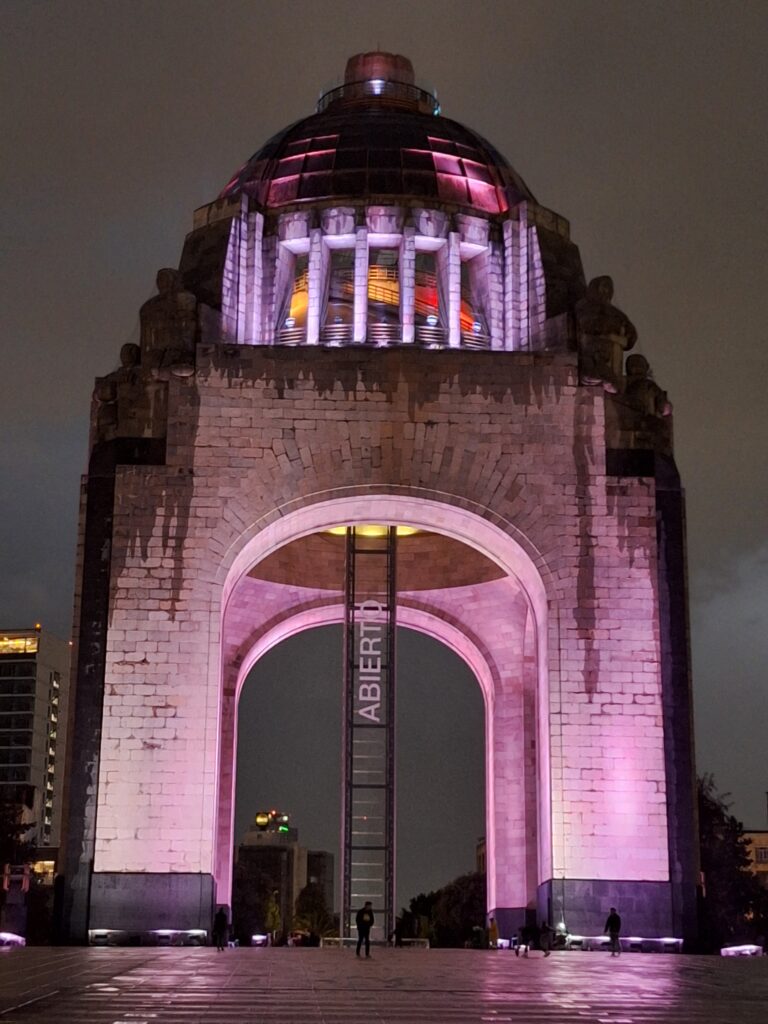
More to See Around the Historical Center of Mexico City
The most notable landmarks and monuments listed above are packed within a 3 km walk, but there are still so many more buildings and plazas to see. If you want to catch the highlights of the historical center, try one of the many Hop On Hop Off buses. To see some of these highlights plus a few extra hidden gems, join a private walking tour with a local guide. Here are a few other notable buildings north and south of the Zocalo.
South of the Zocalo
To the south of Plaza de Constitucion behind the government buildings and two large department stores, you’ll find Iglesia de San Bernardo. Founded in 1636, its outside façade is covered in tezontle a reddish, porous volcanic rock. Casa de los Condes de la Torre Cossío y de la Cortina is nearby and it’s a marvelous example of late 18th century architecture with its ironwork balconies and decorative bastions. Gargoyles in the shape of cannons allude to the original owner’s occupation as a captain-general in the military.
The Parroquia de Jesús Nazareno e Inmaculada Concepción is one of the oldest churches and hospitals in the city where the remains of Hernán Cortés lie. The architecture alone is magnificent with beautiful archways and impressive courtyards, but don’t miss the impressive mural by José Clemente Orozco showing the horrors of WWII. Orozco worked on it from 1942 to 1944 but never finished it. Next door to the church is the Hospital de Jesus built by Cortes to tend to the Aztec warriors wounded during the war with the Spanish.
Interesting fact: In 1646, Hospital de Jesus was the first hospital to perform autopsies on the American continent.
Other monuments include the Monumento a la Mexicanidad, Iglesia Del Señor del Veneno, and the Museo de la Ciudad de Mexico housed in an 18th century former palace and home to artistic exhibitions.
NORTH of the METROPOLITAN CATHEDRAL
Antiguo Colegio de San Idelfonso
This college was founded by the Jesuits in 1588. San Ildefonso was one of the first public buildings to be painted with murals sponsored by the government after the Mexican Revolution (1921). Painters such as Ramón Alva de la Canal, Fermin Revueltas, Fernando Leal, José Clemente Orozco, and Diego Rivera were commissioned to showcase Mexico’s history through their artistry.
Plaza Garibaldi
This historic square is a top tourist and local attraction, and radiates “Mexico”. From mariachi bands serenading passersby and a number of bars and restaurants, rest your feet and enjoy the real Mexican atmosphere.
Take a tour of Museum of Tequila and Mezcal and enjoy a free drink on their rooftop. Hungry? The San Camilitio Gastronomic Market is located nearby. To really experience Plaza Garibaldi, visit on Friday or Saturday night when the music is playing and people are dancing in the square.
WHERE TO STAY IN THE HISTORICAL CENTER OF MEXICO CITY
If you like to be in the heart of the action, then the historical center is the place to be. There always seems to be a celebration going on! But with celebrations, comes noise. If that doesn’t bother you, here are the best hotels in the historical center:
Fromm the stained glass ceiling to the rooftop terrace restaurant and bar, you’ll feel like James Bond enjoying this bit of luxury in Mexico City.
Zocalo Central & Rooftop Mexico City
Rooms are gorgeous, and the with their rooftop restaurant directly across from the cathedral, you will be selfie heaven. Breakfast included.
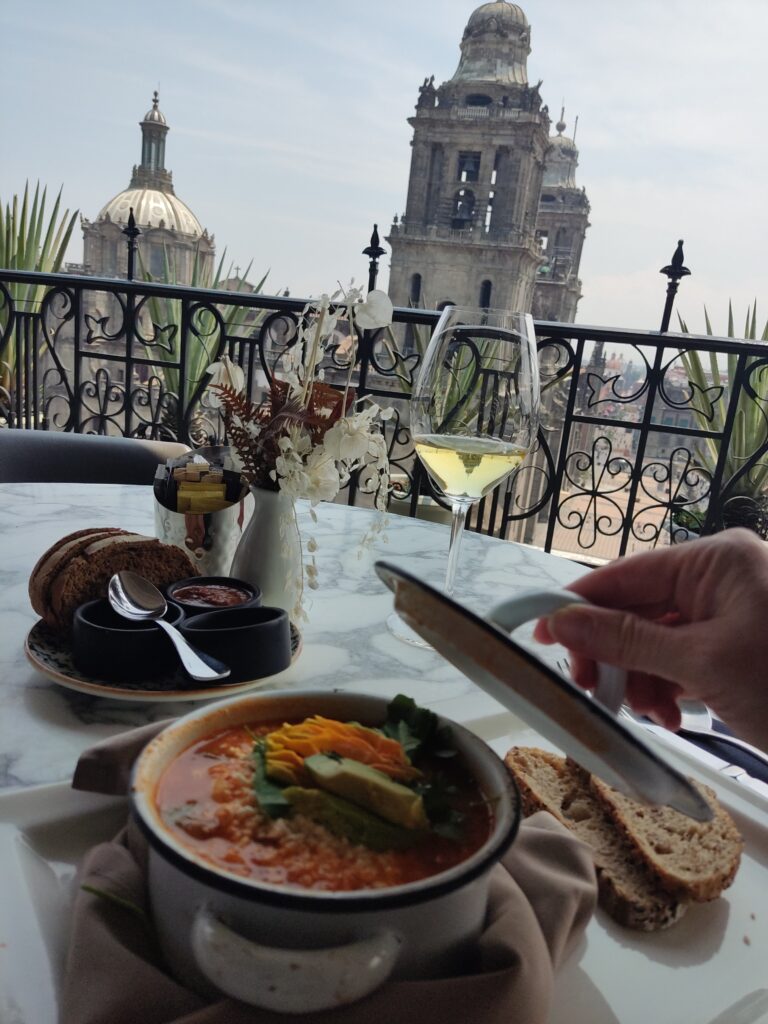
If a sweeping double staircase, stone walls, and modern rooms are on your list, this beautiful hotel checks all the boxes. Breakfast included.
While this is our budget-friendly option, it still delivers historical charm with brick-barreled ceilings and a rooftop restaurant with a view.
WHERE TO EAT IN THE HISTORICAL CENTER OF MEXICO CITY
I’ve already mentioned a few hotel restaurants with great views such as Gran Hotel, Best Western majestic, and the Zocalo Central & Rooftop, but here are a few others with excellent cuisine you should try.
Azul Historico Restaurant
For an enchanting oasis from the hustle of the city, make a reservation for Azul Historico Restaurant. Full grown trees inside provide a mystical vision, and candles cast a romantic glow throughout the courtyard. Seasonal specialties of Mexican cuisine are offered and they have a fantastic wine list.
Limosneros
Another gorgeous restaurant with stone walls and an array of mirrors, Limosneros serves contemporary Mexican cuisine. Try artisanal mezcal and the tasting menu to fully be immersed in the traditional flavors of Mexico. (Recommended by the Michelin Guide to Mexico City.)
La Ópera Bar
La Ópera Bar is a historical restaurant resembling a nostalgic European cafe with its beautiful dark wood bar, cozy seating, and high ceilings. Ask your server to point out the bullet hole in the ceiling. This was supposedly shot by Pancho Villa, a key figure in the revolutionary movement.
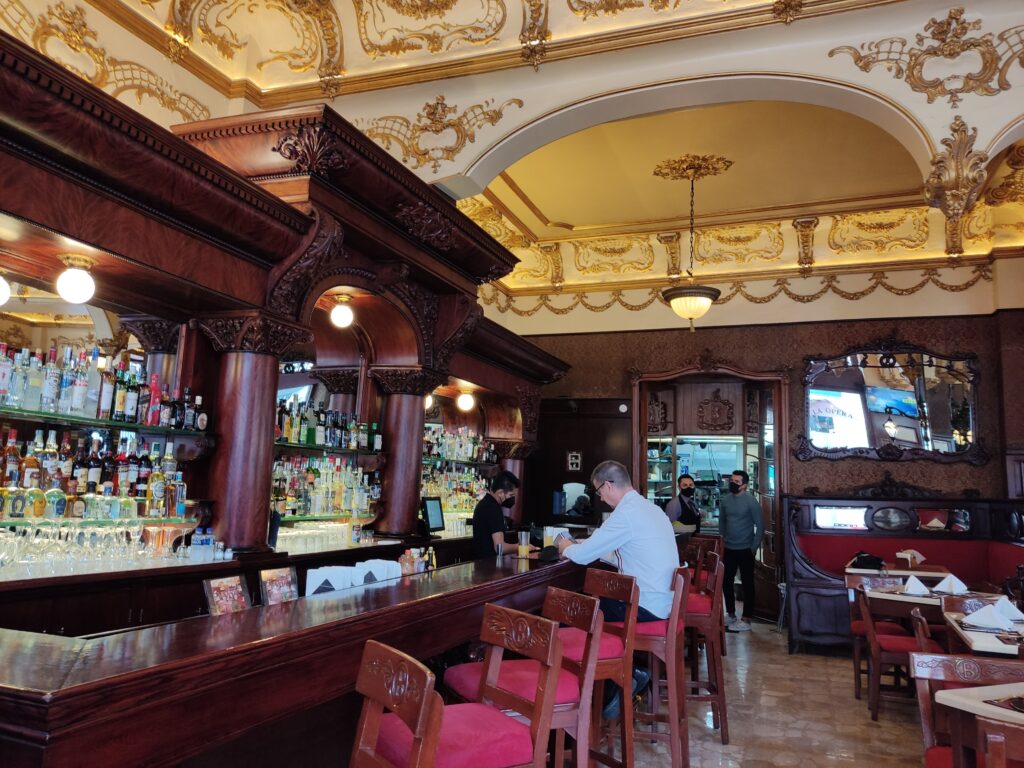
Taquería Los Cocuyos
Looking for something simple and budget-friendly? Taquería Los Cocuyos’ small menu is packed with flavor. Recommended by the Michelin Guide, you can feel safe that you won’t get sick from “Mexican street food”.
These are out top recommendations, but there are plenty of excellent restaurants for you to grab a snack or fancy dinner in the historical center of Mexico City.
How Much Time Do I Need to See the Historical Center of Mexico City?
There is a lot to see and do in the historical center, that one day might not be enough. If possible, spend two days to really explore the attractions fully.
But if you only have one day, you might want to take a walking tour to help guide you to the highlights of the historical center.
If you decide to do it on your own, here is what we recommend:
Start the day at Templo Mayor (before it gets crowded). Visit the cathedral afterward, walk down the walking street to some of the other attractions, and visit Palacio de Bellas Artes. From there, take the Hop On Hop Off Bus to see some of the attractions further out, before returning to Torre Latino. Have a drink at La Opera Bar before dinner at one of the above mentioned restaurants.
We hope this guide helps you find all the historic landmarks you are looking for and get those jaw-dropping Instagram shots everyone drools over. Have a great time exploring the historical center of Mexico City!

